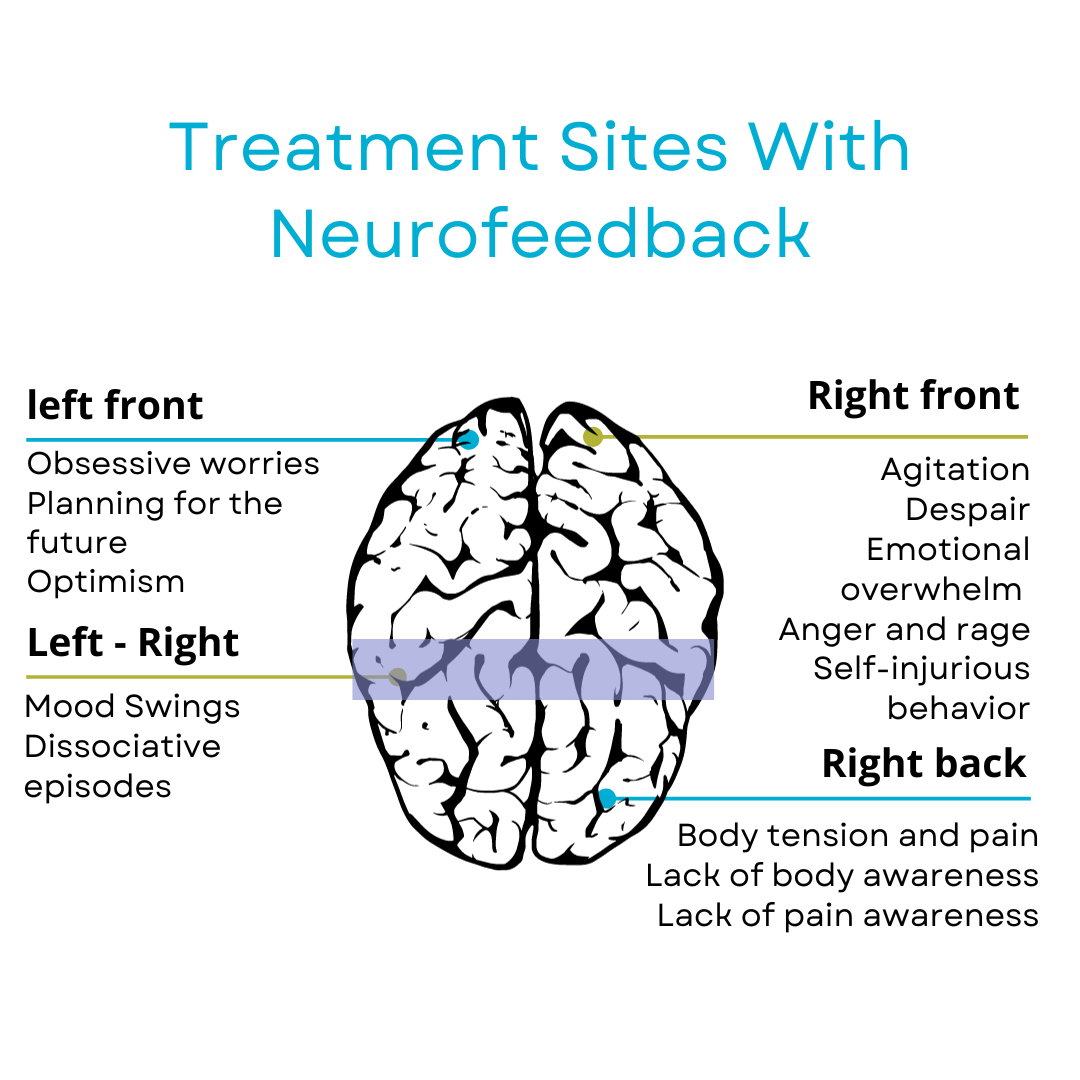Depression & Bipolar Disorder
Research conducted with depression that utilized Neurofeedback showed frontal alpha asymmetry. With Neurofeedback, there are significant changes that occur in the brain. Neurofeedback reduces rumination, and low energy, and improves mood. Neurofeedback therapy works by helping the individual learn how to recognize and control their thoughts and emotions. It can also help the individual to develop healthier coping strategies and manage stress.

Neurofeedback therapy is effective in helping with Depression and bipolar disorder because it helps to identify the underlying causes of the disorder, such as imbalances in brain chemistry, and helps to correct these imbalances. Neurofeedback therapy also helps individuals develop the skills needed to regulate their emotions, allowing them to manage their moods better and reduce symptoms associated with depression and bipolar disorder.
Neurofeedback helps the patient to learn to regulate their own brain waves, allowing them to control their moods better and reduce symptoms of Depression and Bipolar disorder. Depression is a mental disorder characterized by a persistent feeling of sadness and a lack of interest in activities. In contrast, Bipolar disorder is a type of mood disorder characterized by episodes of mania and depression. Neurofeedback therapy can be used to help individuals regulate their moods and reduce symptoms of these disorders.
Studies
Choi SW, Chi SE, Chung SY, Kim JW, Ahn CY, Kim HT. (2011). Is alpha wave neurofeedback effective with randomized clinical trials in depression? A pilot study. Neuropsychobiology. 2011;63(1):43-51. Frontal asymmetric activation has been proposed as a fundamental mechanism underlying depression. Researchers have observed that neurofeedback training targeting asymmetry can enhance depressive symptoms by elevating right frontal alpha activity. This study focused on neurofeedback training specifically designed to amplify the relative activity of the right frontal alpha band, aiming to alleviate symptoms in individuals with depression experiencing emotional, behavioral, and cognitive challenges. The findings indicated that the asymmetry neurofeedback training effectively increased the relative power of right frontal alpha, and this effect persisted even after completing all training sessions. In contrast, the placebo control group showed no significant difference. The neurofeedback training demonstrated significant impacts on both emotion and cognition. Confirming earlier research, enhancing left frontal activity was associated with a reduction in depressive symptoms. Additionally, cognitive assessments revealed that the asymmetry training enhanced performance in executive function tests, distinguishing it from the placebo treatment, which showed no improvement. These preliminary findings suggest that asymmetry training plays a crucial role in emotion regulation and may contribute to the enhancement of left frontal lobe function.
Baehr, E., Rosenfeld, J. P., & Baehr, R. (1997). The clinical use of an alpha asymmetry protocol in the neurofeedback treatment of depression: Two case studies. Journal of Neurotherapy, 2(3), 10-23. This study showcases case reports of two women experiencing depression who underwent over 34 sessions each of EEG biofeedback (neurofeedback) employing an Alpha Asymmetry protocol. The primary objective of this training was to investigate whether alleviation of depression could be achieved by teaching the participants to boost left hemisphere activation and/or diminish right hemisphere activation. To assess changes in personality factors, including depression, the MMPI-2 was administered before and after the training sessions. The outcomes indicate that Alpha Asymmetry neurofeedback training could serve as a valuable complement to psychotherapy in addressing specific categories of mood disorders.
Zotev V., Phillips R., Yuan H., Misaki M. & Bodurka J. (2013) Self-regulation of human brain activity using simultaneous realtime fMRI and EEG neurofeedback. Neuroimage. doi: 10.1016/j.neuroimage.2013.04.126. Neurofeedback is a promising method for adjusting brain activity without invasive procedures, offering potential benefits for treating mental disorders and improving cognitive performance. Typically, neurofeedback techniques use either electroencephalography (EEG) or real-time functional magnetic resonance imaging (rtfMRI). Recent advancements in combining EEG and fMRI simultaneously have opened up new possibilities. Here, we describe the first instance of using a system that integrates real-time data from both rtfMRI and EEG, known as rtfMRI-EEG-nf. We applied this approach to help individuals regulate their emotions in a positive context, where participants recalled happy memories. Using rtfMRI-EEG-nf, participants were able to simultaneously control brain activity in both the left amygdala and the high-beta band of the frontal EEG. These initial results suggest that it’s possible to self-regulate both the blood flow (rtfMRI) and electrical activity (EEG) in the brain at the same time. This finding opens up potential applications for rtfMRI-EEG-nf in developing new research methods in cognitive neuroscience and refining therapeutic approaches for significant neuropsychiatric disorders, particularly depression.
Below you will find a PDF containing the study provided above and more.